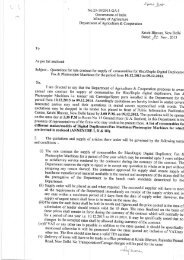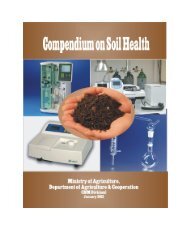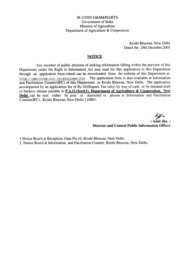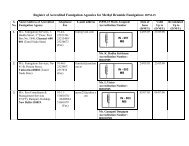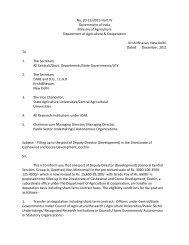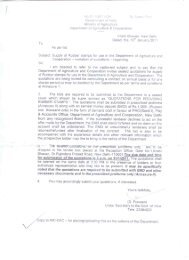canopy management in fruit crops - Department of Agriculture & Co ...
canopy management in fruit crops - Department of Agriculture & Co ...
canopy management in fruit crops - Department of Agriculture & Co ...
Create successful ePaper yourself
Turn your PDF publications into a flip-book with our unique Google optimized e-Paper software.
Pomegranate<br />
Pomegranate has wide range <strong>of</strong> adaptability. It is a deciduous plant under sub<br />
tropics where it is cultivated quite extensively. But under tropical conditions,<br />
pomegranate is an evergreen plant and<br />
thus adds cont<strong>in</strong>uous growth. Under both<br />
situations, this <strong>fruit</strong> tree needs to be tra<strong>in</strong>ed<br />
properly and pruned regularly for better <strong>fruit</strong><br />
production.<br />
For a bush, the plants are tra<strong>in</strong>ed not as<br />
a s<strong>in</strong>gle stem as <strong>in</strong> other <strong>fruit</strong> plants but as<br />
a multi stem. Immediately after plant<strong>in</strong>g <strong>in</strong><br />
the field, it should be headed back to 30-40<br />
cm, assur<strong>in</strong>g the availability <strong>of</strong> a number <strong>of</strong><br />
buds below. Dur<strong>in</strong>g the first grow<strong>in</strong>g season,<br />
about four shoots may be selected which will<br />
form the ma<strong>in</strong> limbs <strong>of</strong> the plant.<br />
•<br />
•<br />
•<br />
•<br />
•<br />
If its plants are to be tra<strong>in</strong>ed to s<strong>in</strong>gle<br />
stem then head<strong>in</strong>g back <strong>in</strong> the field after plantation is done at about 70 cm.<br />
Dur<strong>in</strong>g first year’s growth, 5-6 shoots are selected to form the scaffold limbs.<br />
The ma<strong>in</strong> stem is kept free without any branch up to 40 cm and any shoot, therefore,<br />
com<strong>in</strong>g from below this po<strong>in</strong>t is removed.<br />
The pomegranate has a tendency to put forth many suckers, which need to be<br />
removed right from the beg<strong>in</strong>n<strong>in</strong>g <strong>in</strong> case <strong>of</strong> s<strong>in</strong>gle stem tra<strong>in</strong><strong>in</strong>g.<br />
Pomegranate plants do not require prun<strong>in</strong>g except removal <strong>of</strong> ground suckers, water<br />
shoots, cross branches, dead and diseased twigs, giv<strong>in</strong>g a shape to the tree.<br />
Pomegranate <strong>fruit</strong>s are borne term<strong>in</strong>ally on short spurs, aris<strong>in</strong>g from mature shoots,<br />
which have the capacity to bear <strong>fruit</strong>s for 3-4 years. With advance <strong>in</strong> age they decl<strong>in</strong>e.<br />
A little th<strong>in</strong>n<strong>in</strong>g and prun<strong>in</strong>g <strong>of</strong> old spurs to encourage growth <strong>of</strong> new ones are<br />
required.<br />
Better flower<strong>in</strong>g on properly tra<strong>in</strong>ed plants<br />
Canopy Management <strong>in</strong> Fruit Crops 71



